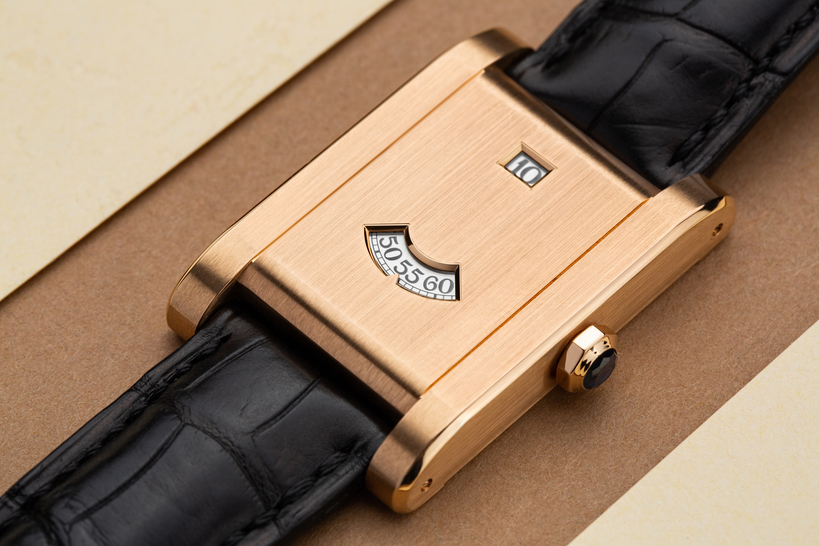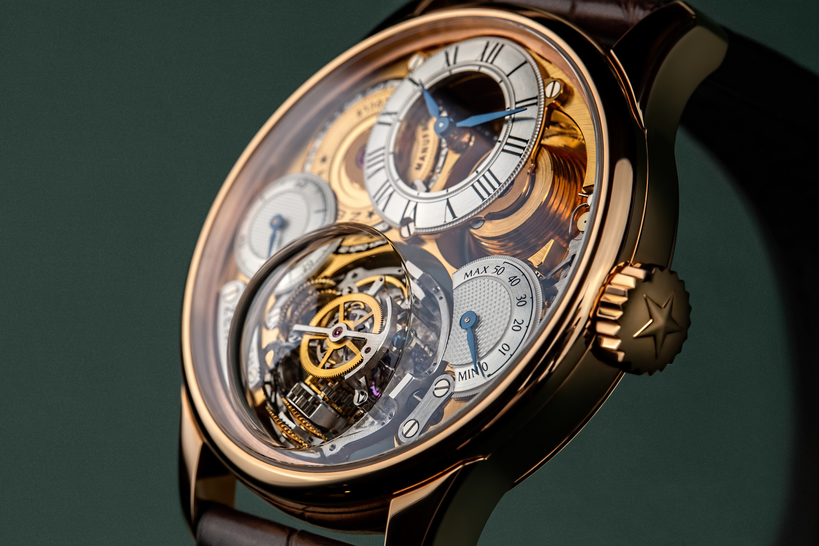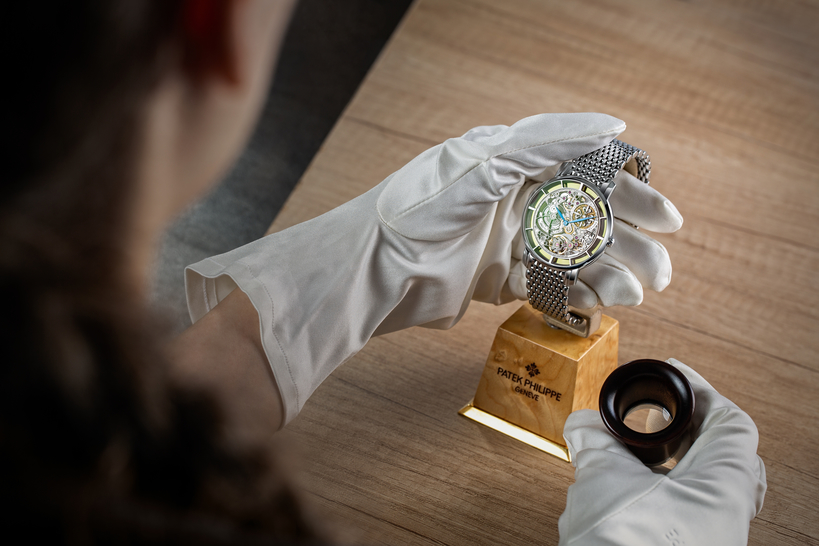Qlekta Editor's Top-5 Watch Debuts.
Leading watch manufacturers have introduced a whole range of interesting novelties that any collector would be happy to add to their collection coming up to the Christmas and New Year's holiday season. Here are the most interesting of them.
Patek Philippe Split-Seconds Monopusher Chronograph Perpetual Calendar ref. 5373P-001
Many a new watch has been unveiled, but as always, it was Patek Philippe who grabbed everyone's attention. There's been particular hype surrounding a split-seconds chronograph with a perpetual calendar for lefties: Patek Philippe 5373P Split-Seconds Monopusher Chronograph with perpetual calendar.
Like all other watches with the winding crown and chronograph pushers located on the left-hand side of the case, it's already been nicknamed "Destro" (Italian for 'right', i.e., the watch is designed to be worn on the right wrist).
The main cause for excitement is the watch's extremely rare combination of complications in the category of Grande Complication, pushers for activation on the left-hand side, along with the dial's bold sporty composition. It's charcoal gray with ebony-black counters, bright white markings and red second hands.
Even Patek's most loyal fans are describing Ref. 5373P as a "rara avis" in press releases, Latin for "rare bird". At the same time, let's not forget it has a platinum case measuring 38.3 mm in diameter and 12.93 mm in height, paired with a sporty strap made of calfskin with an embossed textile texture and red stitching.
Even Patek's most loyal fans are describing Ref. 5373P as a "rara avis" in press releases, Latin for "rare bird".
Rolex set this year's watch trend for lefties, who presented a model at the Genevan Watches & Wonders trade show called GMT-Master II Ref. 126720VTNR. Before this year's novelty, Patek Philippe had only ever released one split-seconds chronograph with the pushers for activating chronograph functions on the left in 1925.
Ref. 5373Р Destro is essentially the same standard split-seconds chronograph with a perpetual calendar as the Patek Philippe Ref. 5372P introduced in 2017. The "engine" under its hood is the manufacture manually wound CHR 27-525 PS Q movement. It's got 476 components, a balance frequency of 3 Hz and a power reserve of 38 – 48 hours.
At 7.3 mm in height, it’s still titleholder as the thinnest split-seconds chronograph movement with a perpetual calendar. The question on everyone's mind is of course whether Ref. 5372 will continue to be produced with Ref. 5372P-001 and 5372P-010 retired.
However, the watchmaker is holding their cards close to their chest as orders continue to come in for the model. Patek Philippe is in no hurry to finalize the retail price for Ref. 5373P-001 either, who have given it an indicative price of CHF 500,000.
New Nautilus
A lid has finally been put on the various rumors regarding the fate of what was still only recently Patek Philippe's most coveted model — the sporty three-hand Nautilus. A successor watch to replace Ref. 5711 is being launched: Ref. 5811/1G-001. The model is almost identical to its predecessor.
The case is just a millimeter wider, now 41 mm in diameter. And they won't be using steel as the case material anymore, the case will be in white gold instead (with the possibility of future cases in different gold tones).
Another difference is the bracelet's micro-adjustment system, which allows the length to be extended by up to 4 mm. This also happens to be a world debut. In general, everything else remains unchanged.
Self-winding Caliber 26-330 S C with its balance beating at a frequency of 4 Hz (28,000 vph), equipped with the trademark Gyromax wheel and Spiromax balance spring. Even the polished and brushed areas on the case and bracelet are in the same spots. Given that white gold is used as the case material, it's now priced at EUR 69,200.
Zeitwerk of our times
In 2009, when Lange & Sohne presented the sensational Zeitwerk model with jumping digital displays for the hours and minutes, the Saxon watchmakers claimed it would become just as iconic as Lange 1.
And they weren't bluffing. It's still not easy to get hold of any edition, whether it be a Striking Time, Minute Repeater, Decimal Strike, Date or skeletonized "Lumen" version. It’s even more surprising that the initial Zeitwerk model has been updated 13 years after its debut.
This is where it even gets hard for experts to tell the novelty apart from the original. You have to admit that with the naked eye, it's difficult to tell the precious 41.9 mm case is 0.4 mm thinner than before. Those who are clued in might say you won't encounter the old combination of case materials and dial colors anymore.
The new versions are in pink gold with a matte black dial (Ref. 142.031) or platinum with a rhodié-colored dial made of solid silver (Ref. 142.025). But it's still hard to say for sure that this isn't the good old Zeitwerk. Is this a reason to go out and search for discontinued Zeitwerks in white gold with a black dial and in pink gold with a silver dial? Probably.
The fact that this is a novelty can be suggested by previously unseen combinations of case materials with the color of the dial.
But as is often the case, the devil is in the details. The new hand-wound manufacture Caliber L043.6 is an improved version of no less than two earlier Zeitwerk movements: L043.8 (Zeitwerk Date) and L043.9 (Zeitwerk Lumen Honeygold).
It has a traditional balance frequency for pocket watches of 2.5 Hz (18,000 vph). It now also belongs to the "Doppelfederhaus" category of movements, with not one but two mainspring barrels for exactly double the power reserve, up from 36 hours to 72 hours.
And finally, you'll find a small carefully disguised pusher for quickly adjusting the hour disk on the caseband at 4 o'clock. The remarkable patented one-minute constant-force escapement remains unchanged.
It plays the important role of compensating for the massive strain on the movement at the moment when the disks turn for the numeral display. No price has been announced just yet. Much depends on demand, and it's sure to be high.
Omega Chrono Chimes
In the year 1892, a company called Louis Brandt & Fils which would later be renamed Omega unveiled the first minute-repeating wristwatch. Strictly speaking, it was a pocket watch with lugs welded on for a strap to be threaded through to wear the repeater on the wrist. Nevertheless, this still counts as a record achievement.
And at the Los Angeles 1932 Summer Olympics, Omega took on the role of Official Timekeeper for the first time. So this year marks two big dates, 90th and 130th anniversaries. Omega has decided to mark them in an unexpected way by launching a monopusher chronograph with a minute repeater.
This is the first time in the watchmaker's recent history that Omega has released a watch with this combination of complications. And they've introduced two models in one go: Omega Olympics 1932 Chrono Chime and Omega Speedmaster Chrono Chime (we couldn't be left without a Speedmaster).
Both of them have 45 mm cases made of the brand's trademark rose-gold alloy Sedna Gold. It took six years to create the extremely complicated Caliber 1932 for these stunning timepieces, which comprises 575 components.
This is the most complicated caliber Omega has ever made — a world-record movement. It's notable for its frequency, running at 5 Hz (36,000 vph), while the mechanism for the minute repeater chimes chronograph readings for the first time.
The first single low note "boom" strikes the minutes (there are only 15 of them because the chronograph counter is only intended to cover a quarter like it did 90 years ago). Then there's the double strike "ding-dong" to sound the ten-second digit, if of course the second hand has already had time to run beyond the ten-second mark, e.g., 12 seconds or 35 seconds.
And finally, there's the high note that chimes single seconds. For instance, 35 seconds are sounded as follows: "ding-dong, ding-dong, ding-dong, ding-ding-ding-ding-ding!"
The Olympic 1932 Chrono Chime's large case width and substantial height at almost 17 mm ensures a clearly audible sound. The dial is coated with Grand Feu enamel. The inner bezel is tilted to a 45-degree angle and made of 925 silver decorated with a guilloché pattern.
The extremely powerful mainspring barrel delivers energy to both the movement and all its modules. It’s allowed Caliber 1932 to achieve Master Chronometer certification. Omega may have limitless opportunities but can only produce about five of these movements per year given that it’s so complex.
So the model is strictly limited for objective reasons, and I think even those at Omega don't know how many years they'll be in production. The price for each Olympic 1932 Chrono Chime is CHF 420,000 and CHF 450, 000 for Speedmaster Chrono Chime.
Chronomètre no. 3
We also recommend keeping an eye on the third Ferdinand Berthoud wristwatch collection inspired by the marine chronometers invented by the brand's namesake. At first glance, Chronomètre FB 3SPC is a significantly simpler model than its predecessors, without any tourbillons or a fusee-and-chain transmission.
However, FB 3SPC is actually a model that's closer to the original marine chronometers completed by the watchmaker Ferdinand Berthoud — the native of Fleurier in the Swiss canton of Neuchâtel who was appointed master watchmaker by the French royal court.
The abbreviation "SPC" in the watch's name is short for "SPiral Cylindrique", French for cylindrical hairspring. It's similar to Arnold's legendary cylindrical hairspring (invented by the great English watchmaker John Arnold) but with a few geometrical differences that have a positive influence on timekeeping accuracy.
It's actually inspired by the creation of Ferdinand Berthoud's nephew, Louis. Terminal curves are of huge significance in these kinds of balance springs, which largely underlie regulation and isochronism.
The abbreviation "SPC" in the watch's name is short for "SPiral Cylindrique", French for cylindrical hairspring.
The most famous of them are Phillips and Breguet curves. The watchmakers at Chopard-owned brand Ferdinand Berthoud worked for two years to develop the perfect curve shape. The resulting SPC springs are hand-curved. At the same time, the watchmakers use a profile projector.
The balance wheel is by no means simple either, equipped with 8 load screws and 4 fine-adjustment screws. That’s the main reason why the hairspring is proudly revealed in full view through a porthole in the case middle at 9 o'clock.
The hand-wound Caliber FB-SPC measuring 37.3 mm in diameter and 6.84 mm in height has a balance frequency of 3 Hz and a 72-hour power reserve. It's housed in a 42.3-mm case in white- or rose-gold.
The series is naturally limited by the capacities of the Chronométrie Ferdinand Berthoud workshop under Chopard, which can only manufacture a maximum of 25 such pieces per year. The model is priced at CHF 140, 000. With the level of work involved, Ferdinand Berthoud's chronometers are soon bound to become auction favorites.




















